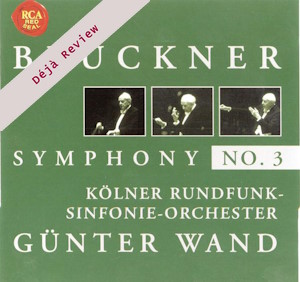
Déjà Review: this review was first published in September 2002 and the recording is still available.
Anton Bruckner (1824-1896)
Symphony No. 3 in D minor (third version: 1889)
Cologne Radio Symphony Orchestra/Günter Wand
rec. 17 May 1981, Grösser Sendsaal, Cologne
RCA 09026 639332 [55]
Günter Wand is one of the great Bruckner interpreters, whose death earlier this year marked the end of an era. This reissue of his 1981 recording of the Third Symphony with his Cologne orchestra is most welcome, since it matches the expectations Wand’s credentials would lead us to expect.
Not that this becomes a clearcut first recommendation; far from it in fact. To begin with, the edition of the score he chooses to perform will raise the hackles of some Bruckner afficionados, because this third version from 1889 cuts a good deal of music. The 1877 version is fuller, the original 1873 score longer still.
The answer, from the enthusiast’s point of view is to own all three and to understand how and why they are different. In reality that is hardly possible or desirable for the majority of collectors, in which case this version as performed by Wand has the advantage of a tauter, shorter approach, though some of the continuity is compromised. But Wand more than most (more than anyone?) knew what he was doing, and if he opted to play this version then we must take him seriously.
The first movement begins with a steady rhythmic pulse, against which the distinctive trumpet theme, which so impressed Wagner, is announced. The shaping, phrasing and tempi are ideal, while the acoustic as captured in the recording allows for clarity if a certain dryness. The Cologne orchestra plays with distinction and commitment, and the climax of the first movement is at once sonorous and urgently compelling.
The slow movement is beautifully done, the ebb and flow of the musical line phrased and shaped with consummate care and understanding. Perhaps the string sound might be more ample in the fully scored passages, but whether this minor caveat is the result of the playing, the recording or the remastering is difficult to tell. In any case it is hardly damaging.
The subtle rhythmic interplays which inform the third movement scherzo have been perfectly judged, so too the recorded balance which gives so much detail. As for the finale, this version makes the movement shorter and less monumental than the earlier editions, but there is no lack of substance in Wand’s interpretation. The second subject, which combines polka and chorale, is nicely shaped. Bruckner said of this music: ‘In the tavern there is dancing, while next door the master lies in his coffin.’ When the final climax rises up and the symphony’s first theme returns, so as to set the seal of unity on the whole conception, one certainly feels that a satisfying and profound journey has reached its conclusion.
For Gunter Wand was a master Brucknerian and his performances set a standard by which other must be judged.
Terry Barfoot
Help us financially by purchasing from




















